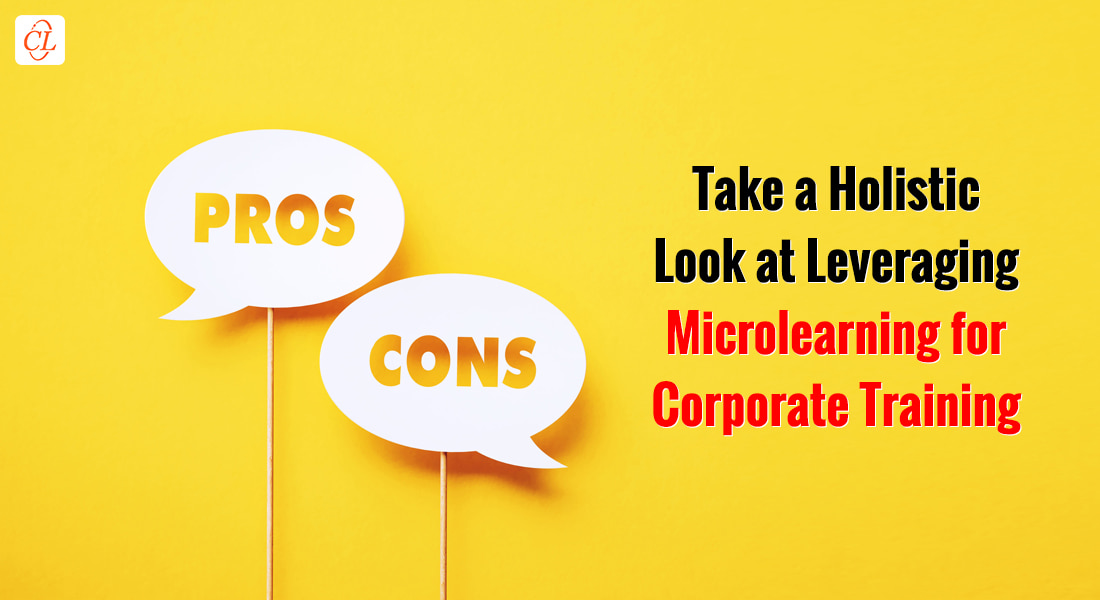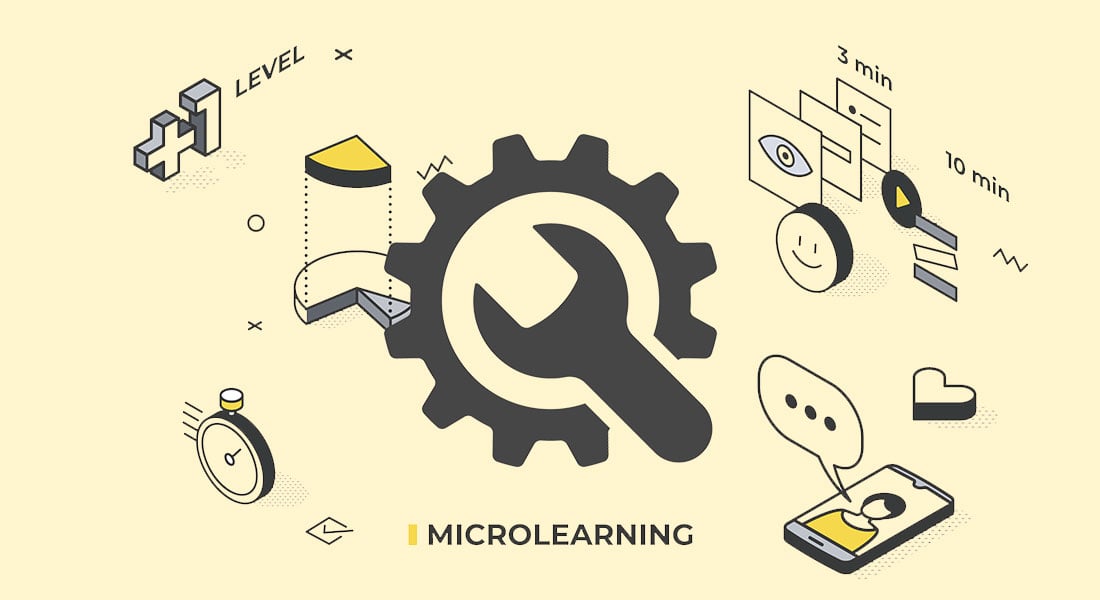The Pros and Cons of Microlearning in Corporate Training

Trainers are working to make corporate training a delightful experience for both learners and their organizations. Learn how to adopt training strategies such as microlearning and eLearning, as companies these days are striving to develop training that’s learner-centric, skill-oriented, and flexible.
In the era of dwindling attention spans, there’s an amplified need for microlearning. Learners need information they can chew on easily, instead of large chunks of information they find hard to take in.
Do you want to know if microlearning is the right tool for you and your organization? Let’s look at it objectively through the pros and cons outlined in this blog!
Can Microlearning Work for You?
Let’s weigh in the pros and cons:
Pros
- Flexibility
- Better Retention
- Employee Engagement
- Efficient Resource Utilization
Cons
- Issues with Long-term Implementation
- Compatibility with Existing Models
Read on to learn more about the advantages and disadvantages of microlearning to help you make an informed decision!
How Does Microlearning Work?
Microlearning is the breaking down of large chunks of information into bite-sized, portable modules. It’s an innovative way of imparting knowledge that can be both informational and fun. Through microlearning tools, such as videos, games, and simulations, learners get to enjoy their learning experience.
If you are wondering how to fit microlearning into your existing training model, then you need look no further. Here are a few ways to adopt microlearning by:
- Offering refresher training for revision of key themes
- Beating the forgetting curve through interactive and snappy content
- Improving knowledge retention
- Providing quick pulse checks to gauge learners’ understanding
- Enabling responsive or mobile-friendly microlearning courses for easy access anytime, anywhere
- Supplying just-in-time learning
- Closing skills and knowledge gaps
Now that you know how to fit microlearning in your training models' have a look at the following infographic to know where can microlearning be used.
Here’s how microlearning fits right into your existing L&D model!
The Benefits of Microlearning
There’s a reason that microlearning is fast becoming the preferred mode of training in organizations around the world. It’s incredibly flexible, absorbable, and resource intensive.
Most learners prefer microlearning over traditional training models, and, in this section, let’s learn the reason behind it. Let’s investigate the perks of microlearning!
1. Learner-Centric Approach
Yes, you need to design training models that benefit entire organizations. However, if your L&D approach is not learner-centric, there’s only so much your organization can get out of it. After all, training programs are meant for learners, and if they aren’t the focus, then your training approach becomes ineffectual.
Many traditional learning models and tools end up forcing information, reducing learners’ retention levels. However, with microlearning, learners grow at their own pace and absorb knowledge efficiently. This way, training becomes even more real and relevant.
2. Less Cognitive Overload
It has been proven that microlearning increases learner retention by 20%. This is mostly because of their easy-to-understand content. Microlearning offers bite-sized information, that makes it simpler for learners to preserve what they’ve learned.
Traditional learning models end up causing cognitive overload and it reduces retention. However, with microlearning, employees access small chunks to increase their information accumulation and assimilation.
3. Resource Friendly
The biggest benefit of microlearning is that organizations reduces the time and cost they spend on corporate training schemes. Microlearning is normally a onetime investment. Organizations don’t need to invest in instructors continuously.
With microlearning, organizations save a lot of time that’s typically spent in the classroom in person. It also saves money as learners don’t need a dedicated trainer or a brick-and-mortar setup. It’s possible to develop microlearning tools and resources with less time and expenditure, and you can use these modules to train multiple batches of learners. This way, you increase the effectiveness of microlearning.
4. Just-in-time Learning
Another spectacular advantage of microlearning both for the employees and organizations is learners can access this tool when they’re most need it. Microlearning tools offer ‘Just-in-Time’ support where learners get the information they need when, let’s say, they’re stuck in a complex situation at work.
Instead of having to go through copious amounts of text to solve a small problem, learners can simply load a microlearning module and get almost instant learning support. This improves their performance and enhances their knowledge of the challenges and solutions associated with their job.
5. Improved Engagement
Traditional learning models can be mundane and mind-numbing, what with hours of sitting in one place and obliged to learn. However, microlearning makes knowledge acquisition interesting with assets, such as quizzes, simulations, and videos.
Microlearning improves employee engagement, allowing workers to connect with their organization. When they access information, conveniently and quickly, they get to overcome hurdles and troubleshoot problems on their own, improving their motivation and growth.
6. Flexibility
Boredom and the ‘have-to’ approach are key factors dissuading people from traditional learning. Microlearning can reduce distractions and stop learners from disconnecting with the training by providing flexibility of access.
Microlearning tools are available easily on any device and at all hours. With the flexibility to learn based on learners needs, at times that are convenient, learners improve their engagement and absorption of information.
The Drawbacks of Microlearning
Microlearning seems like the best thing in the world of learning and development, now that we’ve studied the benefits of this avant-garde approach. Well, it’s not all rainbows, as most people believe.
Microlearning comes with its own set of disadvantages as well. Let’s look at them here!
1. Might Not Fit
Microlearning might not fit into all training programs. Its primary goal is to provide complex information in small chunks. However, course developers cannot break down comprehensive courses, such as compliance training, to the micro level.
For some roles, microlearning could do more harm than good because learners get information in part and not the whole of it. However, eLearning providers can add microlearning as a layer in the training program, providing just-in-time solutions and refresher training.
2. Unorganized
One of the potential drawbacks of microlearning is its disorganization. Most microlearning tools are like pieces in a puzzle that come together to form the larger picture. However, if learners are not careful, they might not access a few pieces, and lose out on the big picture. This way, they don’t achieve optimal learning outcomes.
This disorganization in microlearning might cost employees that get equipped with some skills but miss out on others. However, you can overcome this problem by supervising training material and learners’ progress.
3. One Goal One Module
While learning for a mere few minutes is tempting, it’s hard to learn an entire skill in under 10 minutes. Employees might attend an entire course in a single day with traditional classroom instruction. However, achieving similar learning in a day with microlearning tools might not be possible as it breaks concepts down into one learning goal per module.
If your learners need complete and comprehensive understanding of your chosen topic, then stick to a larger training plan and use diverse approaches.
4. Long-Term Goals
Microlearning focuses on one learning goal in each module. However, long-term learning outcomes are extremely complex and multifaceted. Microlearning is meant to fulfil just-in-time learning needs and are not meant to meet long-term learning goals that are complex and detailed.
Summing Up
When we look at the latest L&D models and tools, such as blended learning and microlearning, there’s a lot more to gain than lose. These approaches match the needs of the current workforce who get the most out of their resources. However, no learning tool can be a one-size-fits-all.
The best way to evaluate whether microlearning is an effective and efficient method of imparting training is to fit it into existing training models. This process might give you a fair idea of how to maximize productivity. Get this eBook to learn about how to integrate microlearning with your training strategy.
Editor’s note: This post was originally published in June 2022 and has been updated for comprehensiveness.







